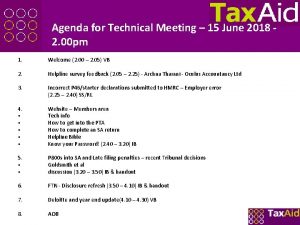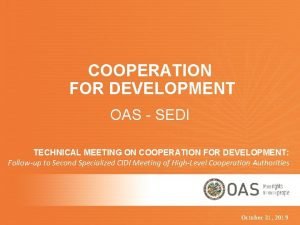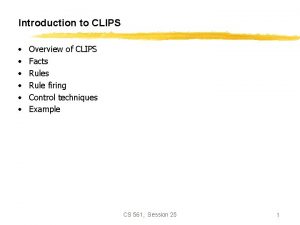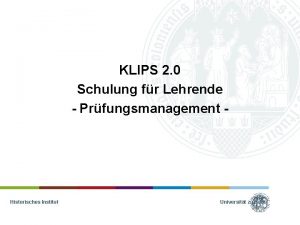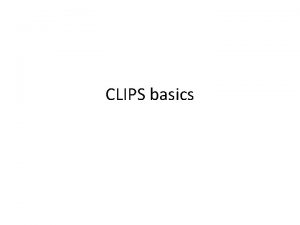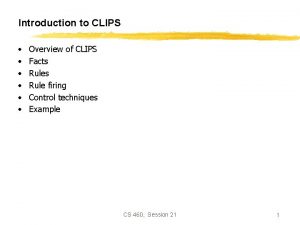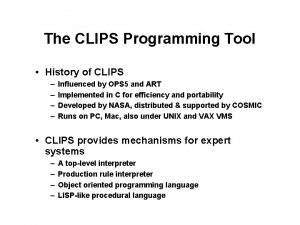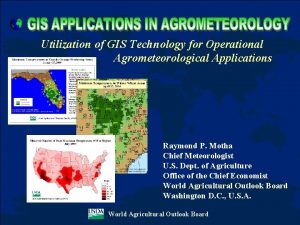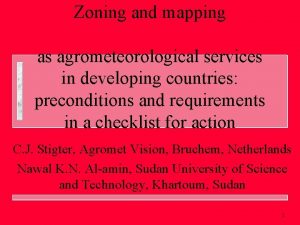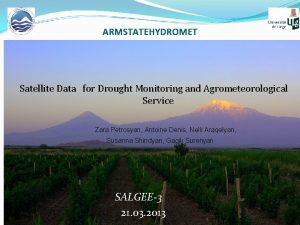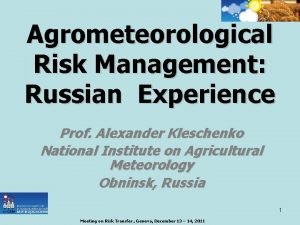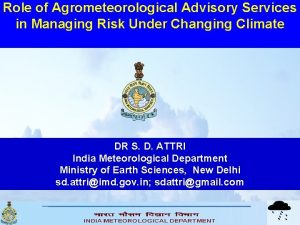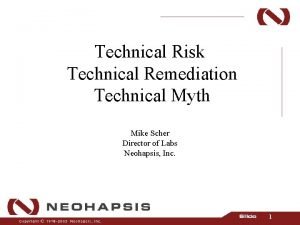Regional Technical Meeting on CLIPS and Agrometeorological Applications

























- Slides: 25

Regional Technical Meeting on CLIPS and Agrometeorological Applications for the Mercosur Countries Campinas – SP – Brazil, 13 -16 July 2005 Climate change: effects on plant pests and diseases in Brazil Emília Hamada emilia@cnpma. embrapa. br Raquel Ghini raquel@cnpma. embrapa. br

Presentation Outline • Plant pests and diseases and climate change • A study: Coffee leaf miner and nematode • Main challenges

• Agriculture is the most weather dependent sector • The goal of protecting plants is to reduce the damage caused by phytosanitary problems to reach the potential production of the plants. • Studying the possible effects of climate change on the plant pests and disease is essencial to adopt mitigated actions

DISEASE TRIANGLE Environment Disease Host plant Pathogen • Phytopathology paradigm: interactions between susceptible host plant, virulent pathogen and suitable environment

• The pathogen tends to follow the host plant in its geographical distribution • The development stages of pathogen and host plant are affected by the environment • Climage change can affect pathogen, host plant and interaction between them

A STUDY: COFFEE LEAF MINER AND NEMATODE Coffee leaf miner (Perileucopter coffeela) is the most important pest of coffee plants This pest occurs in all Brazilian producing regions The lost is of the order of 37% in some regions of São Paulo State

Coffee nematode (Meloidogyne incognita) is the most important nematode´s species in Brazil.

• Members of the study: Raquel Ghini (Embrapa Meio Ambiente) Emília Hamada (Embrapa Meio Ambiente) Mario José Pedro Junior (IAC) José Antonio Marengo (CPTEC-INPE) • Goal: Compare the geographic distribution maps of probable number of coffee leaf miner cicles and coffee nematode generations, considering the actual scenario and the future scenarios

MATERIAL AND METHODS GIS + Biological + models Climate data Coffee leaf miner Actual (1961 -1990) Coffee nematode Future (IPCC)

Climate data Future (IPCC - DCC) • 2020 (2010 – 2039) • 2050 (2040 - 2069) • 2080 (2070 – 2099) A 2 and B 2 scenarios


Climate models and variables Model ECHAM Had. CM 3 GFDL CGCM CSIRO CCSR Spatial 2. 8 X 2. 8 3. 7 X 2. 5 3. 7 X 2. 2 3. 7 X 3. 7 5. 6 X 3. 2 5. 6 X 5. 6 Grid 128 X 64 96 X 73 96 X 80 96 X 48 54 X 56 64 X 32 Tm X X X Tmax ND X X X Tmin ND X X X Solar. R X X X Precip X X X ND ND RH Spatial resolution: 0. 5 X 0. 5 degrees Interpolation: Square Inverse Distance

Mean Temperature - October – A 2 scenario 2020 2050 2080

Maximum Temperature – October – A 2 scenario 2020 2050 2080

Relative Humidity – October – A 2 scenario 2020 2050 2080

Biological models Coffee leaf miner – Parra (1985) Coffee nematode – Jaehn (1991) Direct effect of the temperature

Probable number of coffee leaf miner cycles – October – A 2 scenario 61% 32% 4% 2020 2050 2080

Probable annual number of coffee leaf miner cycles – A 2 scenario Actual 2020 2080

Probable number of coffee nematode generations - October - 2080 48% 65% Breeds 1 and 2 - A 2 Breeds 1 and 2 - B 2 Breed 4 - A 2

Probable annual number of coffee nematode generations breed 1, 2 Actual 2080 – A 2

CONCLUSIONS • The incidence of coffee leaf miner and nematode can increase in the future • The phytosanitary problems are increasing considering 2020, 2050, and 2080 • The B 2 scenario is less pessimistic than the A 2 scenario

• Parra´s model was developed to São Paulo state, but the results are well fitted for the purpose of considering the actual scenario to all the country • The highest rate of pest plant development occurs in October, in both actual and future scenarios • Similar tendency is observed to coffee nematode. Highest number of development of breeds 1 and 2 compared to breed 4

Continuing the study… Diseases • Coffee: Rust • Bean: Rust, Angular Leaf Spot • Banana: Yellow Sigatoka

MAIN CHALLENGES • The most of biological models of plants or disease and pests of plants require daily, sometimes hourly information • The global circulation climatic models frequently have low spatial and temporal resolution • Challenge: Adjust the requirements of biological models available and of global circulations models • Tendency: regionalization – downscalling • Spatial resolution – Temporal resolution

THANK YOU!!
 Regional technical forum
Regional technical forum What is meeting and types of meeting
What is meeting and types of meeting Types of meeting
Types of meeting Tata cara technical meeting lomba
Tata cara technical meeting lomba Rundown technical meeting lomba online
Rundown technical meeting lomba online Technical meeting agenda
Technical meeting agenda Peraturan lomba rebutan kursi
Peraturan lomba rebutan kursi Technical interchange meeting template
Technical interchange meeting template Oas technical meeting
Oas technical meeting Tcm technical committee meeting
Tcm technical committee meeting Today meeting or today's meeting
Today meeting or today's meeting Today meeting or today's meeting
Today meeting or today's meeting Situational leadership grid
Situational leadership grid Princess fiona fights robin hood
Princess fiona fights robin hood Functions of eye piece
Functions of eye piece Clips rules example
Clips rules example Examples of satire in shrek
Examples of satire in shrek Body part of microscope
Body part of microscope Clips expert system example
Clips expert system example Clips decision tree example
Clips decision tree example Sports clips camby
Sports clips camby Atypical clips
Atypical clips Klips2 uni köln
Klips2 uni köln A bar magnet that holds a chain of paper clips illustrates
A bar magnet that holds a chain of paper clips illustrates Jess java
Jess java March identifier clips
March identifier clips





